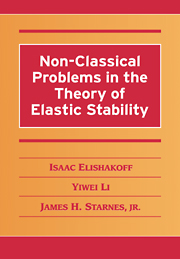Book contents
- Frontmatter
- Contents
- Preface: Why Still Another Book on Stability?
- 1 Mode Localization in Buckling of Structures
- 2 Deterministic Problems of Shells with Variable Thickness
- 3 Stochastic Buckling of Structures: Monte Carlo Method
- 4 Stochastic Buckling of Structures: Analytical and Numerical Non-Monte Carlo Techniques
- 5 Anti-Optimization in Buckling of Structures
- 6 Application of the Godunov-Conte Shooting Method to Buckling Analysis
- 7 Application of Computerized Symbolic Algebra in Buckling Analysis
- Bibliography
- Author Index
- Subject Index
5 - Anti-Optimization in Buckling of Structures
Published online by Cambridge University Press: 06 January 2010
- Frontmatter
- Contents
- Preface: Why Still Another Book on Stability?
- 1 Mode Localization in Buckling of Structures
- 2 Deterministic Problems of Shells with Variable Thickness
- 3 Stochastic Buckling of Structures: Monte Carlo Method
- 4 Stochastic Buckling of Structures: Analytical and Numerical Non-Monte Carlo Techniques
- 5 Anti-Optimization in Buckling of Structures
- 6 Application of the Godunov-Conte Shooting Method to Buckling Analysis
- 7 Application of Computerized Symbolic Algebra in Buckling Analysis
- Bibliography
- Author Index
- Subject Index
Summary
So far as the laws of mathematics refer to reality, they are not certain. And so far as they are certain, they do not refer to reality.
A. EinsteinTo a person who is studying algebra, it is often more useful to solve the same problem with three or four different methods, than to solve three or four different problems. By solving problems by different methods, one can by the comparison clarify which of them is shorter and more effective.
W. W. SoyerThe subject of probability is over two hundred years old and for the whole period of its existence there has been dispute about its meaning.
D. V. LindleyA thousand probabilities do not make one truth.
English proverbProbability does not exist.
B. de FinettiI see and approve better things, but follow worse.
Publius Ovidius NasoIn a traditional probabilistic analysis, the statistical parameters of uncertain quantities initial geometric imperfections or elastic moduli are presumed to be known, which must be inferred from on-site measurements. Because the available data of such measurements are often limited to permit the probabilistic analysis, a new discipline, called convex modeling of uncertainty, is applied to obtain estimates of the upper and lower bounds of the buckling loads. From a structural safety point of view, the least favorable lower buckling load should be used in design. Critical comparison of the probabilistic and convex analyses is performed.
- Type
- Chapter
- Information
- Non-Classical Problems in the Theory of Elastic Stability , pp. 222 - 256Publisher: Cambridge University PressPrint publication year: 2001



